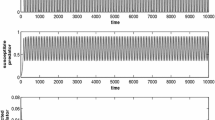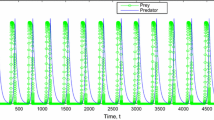Abstract
The effect of parasites and pathogens in prey populations received a lot of attention but disease in predator population has been studied comparatively little in literature. In the present paper we consider a predator–prey model with disease in predator population. We analyze the local stability of model system around the equilibria. We derive the ecological as well as disease basic reproduction numbers and study the community structure of model system by these numbers. We work out the conditions of Hopf bifurcation and persistence of system. Our numerical results reveals that system shows chaotic dynamics for increasing the infection in predator. It is also observe that half saturation constant is responsible for occurrence and control of chaos.





Similar content being viewed by others
References
Anderson, R.M., May, R.M.: The population dynamics of microparasites and their invertebrate hosts. Philos. Trans. R. Soc. Lond. Ser. B291, 451–524 (1981)
Anderson, R.M.: Transmission dynamics and control of infectious disease agents. In: Anderson, R.M., May, R.M. (eds.) Population Biology of Infectious Diseasess, pp. 149–176. Springer, Berlin (1982)
Anderson, R.M., May, R.M.: The invasion, persistence and spread of infectious diseases within animal and plant communities. Philos. Trans. R. Soc. Lond. B 314, 533–570 (1986)
Anderson, R.M., May, R.M.: Infectious Diseases of Humans. Dynamics and Control. Oxford University Press, Oxford (1991)
Arino, O., Abdllaoui, A., Mikram, J., Chattopadhyay, J.: Infection on prey population may act as a biological control in ratio-dependent predator–prey model. Nonlinearity 17, 1101–1116 (2004)
Capasso, V., Serio, G.: A generalization of the Kermack–McKendrick deterministic epidemic model. Math. Biosci. 42, 4161 (1978)
Chatterjee, S., Bandyopadhyay, M., Chattopadhyay, J.: Proper predation makes the system disease free- conclusion drawn from an eco-epidemiological model. J. Biol. Syst. 14(4), 599–616 (2006)
Chattopadhyay, J., Arino, O.: A predator–prey model with disease in the prey. Nonlinear Anal. 36, 747–766 (1999)
Coyner, D.F., Schaack, S.R., Spalding, M.G., Forrester, D.J.: Altered predation susceptibility of Mosquitofish infected with Eu- strongylides ignotus. J. Wildl. Dis. 37(3), 556–560 (2001)
Diekmann, O., Heesterbeek, J.A.P., Metz, J.A.J.: On the definition and the computation of the basic reproductive ratio \(R_0\) in models for infectious diseases in heterogeneous populations. J. Math. Biol. 28, 365–382 (1990)
Dobson, A.P.: The population biology of parasite induced changes in host behaviour. Q. Rev. Biol. 63, 139–165 (1988)
Eisenberg, J.N., Maszle, D.R.: The structural stability o f a three-species food chain model. J. Theor. Biol. 176, 501–510 (1995)
Ebert, D., Lipsitch, M., Mangin, K.L.: The effect of parasites on host population density and extinction: experimental epidemiology with Daphnia and six microparasites. Am. Nat. 156, 459477 (2000)
Eppley, R.W., Rogers, J.N., McCarthy, J.J.: Half-saturation constants for uptake of nitrate and ammonium by marine phytoplankton. Limnol. Oceanogr. 14(6), 912–920 (1969)
Gilpin, M.E.: Spiral chaos in a predator–prey model. Am. Nat. 107, 306–308 (1979)
Godfrey, H.C.J., Grenfell, B.T.: The continuing quest for chaos. Trends Ecol. Evol. 8, 43–44 (1993)
Greenhalgh, D., Haque, M.: A predator–prey model with disease in the prey species only. Math. Meth. Appl. Sci. 30, 911929 (2006)
Grenfell, B.T., Dobson, A.P. (eds.): Ecology of Infectious Diseases in Natural Populations. Cambridge University Press, Cambridge (1995)
Grenfell, B.T., Kleczkowski, A., Ellner, S.P., Bolker, B.M.: Measles as a case-study in nonlinear forecasting and chaos. Philos. Trans. R. Soc. Lond. 348, 515–530 (1995)
Haque, M., Venturino, E.: The role of transmissible diseases in the Holling–Tanner predator–prey model. Theor. Appl. Biol. 70, 273–288 (2006)
Haque, M., Venturino, E.: An ecoepidemiological model with disease in predator: the ratio-dependent case. Math. Meth. Appl. Sci. 30, 17911809 (2007)
Hassell, M.P., Varley, G.C.: New inductive population model for insect parasites and its bearing on biological control. Nature (London) 223, 1133–1137 (1969)
Hastings, A., Powell, T.: Chaos in three-species food chain. Ecology 72(3), 896–903 (1991)
Hastings, A., Hom, C.L., Ellner, S., Turchin, P., Godfray, H.C.J.: Chaos in ecology: is mother nature a strange attractor? Ann. Rev. Ecol. Syst. 24, 1–33 (1993)
Hadeler, K.P., Freedman, H.I.: Predator–prey populations with parasitic infection. J. Math. Biol. 27, 609–631 (1989)
Han, L., Ma, Z., Hethcote, H.W.: Four predator prey models with infectious diseases. Math. Comp. Model. 34, 849858 (2001)
Hethcote, H.W., Han, W.W.L., Zhien, Ma.: A predator–prey model with infected prey. Theor. Popul. Biol. 66, 259–268 (2004)
Holmes, J.C., Bethel, W.M.: Modification of intermediate host behaviour by parasites. In: Canning, E.U., Wright, C.A. (eds.) Behavioural Aspects of Parasites Transmission, pp. 123–149. Academic Press, London (1972)
Kermack, W.O., Mc Kendrick, A.G.: Contributions to the mathematical theory of epidemics, part 1. Proc. R. Soc. Lond. Ser. A 115, 700–721 (1927)
Lotka, A.J.: Elements of Physical Biology. Williaams and Wilkins Co., Inc., Baltimore (1924)
Lafferty, K.D., Morhis, A.K.: Altered behaviour of parasitized killifish increases susceptibility to predation by bird final hosts. Ecology 77, 1390–1397 (1996)
May, R.M.: Simple mathematical models with very complicated dynamics. Nature 261, 459–467 (1976)
May, R.M., Anderson, R.M.: Population biology of infectious diseases II. Nature 280, 455 461 (1979)
McCann, K., Yodzis, P.: Biological conditions for chaos in a three-species food chain. Ecology 75(2), 561–564 (1994)
Mena-Lorca, J., Hethcote, H.W.: Dynamic models of infectious diseases as regulators of population size. J. Math. Biol. 30, 693716 (1992)
Olsen, L.F., Truty, G.L., Schaffer, W.M.: Oscillations and chaos in epidemics: a non-linear dynamic study of six childhood diseases in Copenhagen, Denmark. Theor. Popul. Biol. 33, 344–370 (1988)
Pielou, E.C.: Introduction to Mathematical Ecology. Wiley-Interscience, New York (1969)
Ruxton, G.D.: Low levels of immigration between chaotic populations can reduce system extinctions by inducing asynchronous cycles. Proc. R. Soc. Lond. B 256, 189–193 (1994)
Ruxton, G.D.: Chaos in a three-species food chain with a l ower bound on the bottom population. Ecology 77(1), 317–319 (1996)
Schaffer, W.M., Kot, M.: Do strange attractors govern ecological systems? BioScience 35, 342–350 (1985)
Schaffer, W.M., Kot, M.: Chaos in ecological systems the coals that Newcastle forgot. Trends Ecol. Evol. 1, 58–63 (1986)
Singh, S., Chandra, P., Shukla, J.B.: Modeling and analysis of spread of carrier dependent infectious diseases with environmental effects. J. Biol. Syst. 11, 325335 (2003)
Toetz, D.W., Varga, L.P., Loughran, E.D.: Half-saturation constants for uptake of nitrate and ammonia by reservoir plankton. Ecology 54(4), 903–908 (1973)
Upadhyay, R., Bairagi, N., Kundu, K., Chattopadhyay, J.: Chaos in eco-epidemiological problem of Salton Sea and its possible control. Appl. Math. Comput. 196(1), 392–401 (2007)
Venturino, E.: The influence of disease on Lotka–Volterra systems. Rky. Mt. J. Math. 24, 381402 (1994)
Venturino, E.: Epidemics in predator–prey model: disease in the predators. IMA J. Math. Appl. Med. Biol. 19, 185–205 (2002)
Xiao, Y., Chen, L.: Modelling and analysis of a predator–prey model with disease in the prey. Math. Biosci. 171, 59–82 (2001)
Acknowledgments
The authors are grateful to the reviewer for their helpful comments and suggestions.
Author information
Authors and Affiliations
Corresponding author
Rights and permissions
About this article
Cite this article
Das, K.p. Disease-Induced Chaotic Oscillations and its Possible Control in a Predator–Prey System with Disease in Predator. Differ Equ Dyn Syst 24, 215–230 (2016). https://doi.org/10.1007/s12591-015-0249-7
Published:
Issue Date:
DOI: https://doi.org/10.1007/s12591-015-0249-7




